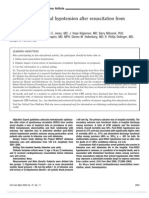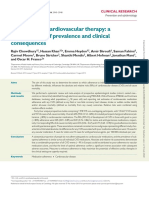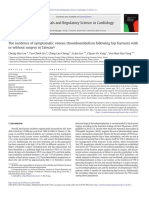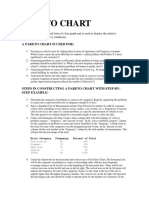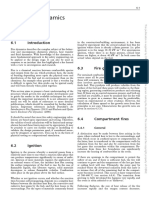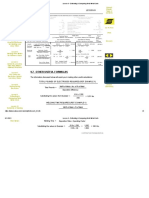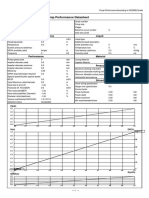The Impact of Severe Traumatic Brain Injury On A Novel Base Deficit-Based Classification of Hypovolemic Shock
The Impact of Severe Traumatic Brain Injury On A Novel Base Deficit-Based Classification of Hypovolemic Shock
Uploaded by
Dmoney PtcCopyright:
Available Formats
The Impact of Severe Traumatic Brain Injury On A Novel Base Deficit-Based Classification of Hypovolemic Shock
The Impact of Severe Traumatic Brain Injury On A Novel Base Deficit-Based Classification of Hypovolemic Shock
Uploaded by
Dmoney PtcOriginal Title
Copyright
Available Formats
Share this document
Did you find this document useful?
Is this content inappropriate?
Copyright:
Available Formats
The Impact of Severe Traumatic Brain Injury On A Novel Base Deficit-Based Classification of Hypovolemic Shock
The Impact of Severe Traumatic Brain Injury On A Novel Base Deficit-Based Classification of Hypovolemic Shock
Uploaded by
Dmoney PtcCopyright:
Available Formats
ORI GI NAL RESEARCH Open Access
The impact of severe traumatic brain injury
on a novel base deficit- based classification
of hypovolemic shock
Manuel Mutschler
1,2*
, Ulrike Nienaber
3
, Arasch Wafaisade
1
, Thomas Brockamp
1
, Christian Probst
1
, Thomas Paffrath
1
,
Bertil Bouillon
1
, Marc Maegele
1
and the TraumaRegister DGU
Abstract
Background: Recently, our group has proposed a new classification of hypovolemic shock based on the physiological
shock marker base deficit (BD). The classification consists of four groups of worsening BD and correlates with the extent
of hypovolemic shock in severely injured patients. The aim of this study was to test the applicability of our recently
proposed classification of hypovolemic shock in the context of severe traumatic brain injury (TBI).
Methods: Between 2002 and 2011, patients 16 years in age with an AIS
head
3 have been retrieved from the German
TraumaRegister DGU database. Patients were classified into four strata of worsening BD [(class I (BD2 mmol/l), class II
(BD> 2.0 to 6.0 mmol/l), class III (BD> 6.0 to 10 mmol/l) and class IV (BD> 10 mmol/l)] and assessed for demographic
and injury characteristics as well as blood product transfusions and outcomes. The cohort of severely injured patients
with TBI was compared to a population of all trauma patients to assess possible differences in the applicability of the BD
based classification of hypovolemic shock.
Results: From a total of 23,496 patients, 10,201 multiply injured patients with TBI (AIS
head
3) could be identified. With
worsening of BD, a consecutive increase of mortality rate from 15.9% in class I to 61.4% in class IV patients was observed.
Simultaneously, injury severity scores increased from 20.8 (11.9) to 41.6 (17). Increments in BD paralleled decreasing
hemoglobin, platelet counts and Quicks values. The number of blood units transfused correlated with worsening of BD.
Massive transfusion rates increased from 5% in class I to 47% in class IV. Between multiply injured patients with TBI and
all trauma patients, no clinically relevant differences in transfusion requirement or massive transfusion rates were observed.
Conclusion: The presence of TBI has no relevant impact on the applicability of the recently proposed BD-based
classification of hypovolemic shock. This study underlines the role of BD as a relevant clinical indicator of hypovolaemic
shock during the initial assessment in respect to haemostatic resuscitation and transfusion requirements.
Keywords: Trauma, Shock, Classification, Vital signs, Base deficit, Transfusion, Traumatic brain injury
Background
Uncontrolled haemorrhage is still responsible for the
half of all trauma-related deaths within the first 48 hours
after hospital admission [1-3]. This underlines the piv-
otal role of the early recognition and treatment of hypo-
volaemia in acute trauma care. The Advanced Trauma
Life Support (ATLS) proclaims for the initial evaluation
of circulatory depletion four classes of hypovolemic
shock based upon an estimated blood loss in percent
and corresponding vital signs [4]. However, recent ana-
lyses on data of multiple injured patients derived from
the TraumaRegister DGU and the TARN (Trauma
Audit and Research Network) database indicated that
the current ATLS classification of hypovolemic shock
displays substantial deficits in the initial assessment of
multiply injured trauma patients [5-8].
Based on these observations, we developed and vali-
dated a new classification of hypovolemic shock on the
* Correspondence: manuelmutschler@web.de
1
Department of Trauma and Orthopedic Surgery, Cologne-Merheim Medical
Center (CMMC), University of Witten/Herdecke, Ostmerheimer Str. 200,
D-51109 Cologne, Germany
2
Institute for Research in Operative Medicine (IFOM), University of Witten/
Herdecke, Ostmerheimer Str. 200, D-51109 Cologne, Germany
Full list of author information is available at the end of the article
2014 Mutschler et al.; licensee BioMed Central Ltd. This is an Open Access article distributed under the terms of the Creative
Commons Attribution License (http://creativecommons.org/licenses/by/2.0), which permits unrestricted use, distribution, and
reproduction in any medium, provided the original work is properly credited.
Mutschler et al. Scandinavian Journal of Trauma, Resuscitation and Emergency Medicine 2014, 22:28
http://www.sjtrem.com/content/22/1/28
physiological shock marker base deficit (Table 1) [9].
The defined four strata of worsening BD indicated the
acute presence of hypovolemic shock related to the need
for haemostatic resuscitation, transfusion requirement, la-
boratory findings and outcomes [9]. This new classification
of hypovolemic shock predicted transfusion requirements
and mortality even more appropriately than the current
ATLS classification of hypovolemic shock [9].
More than 40% of all trauma patients captured in the
TraumaRegister DGU sustain a combination of injuries
including severe traumatic brain injury (TBI) [8]. To-
gether with hemorrhage, TBI is the leading cause of
death in multiply injured trauma patients [1-3,10] and
the coincidence of TBI and hemorrhage has been associ-
ated with an even worse overall morbidity and mortality
[11]. Several studies have shown that TBI may impair
cardiovascular compensation to acute blood loss [12-16].
In detail, it has been demonstrated that the autonomic
response to haemorrhage is disturbed in the presence of
TBI and the physiological response to acute blood loss,
like hypotension or the modification of vascular tone
may be impaired or delayed [14,15,17]. Yuan and col-
leagues even demonstrated that TBI may suppress spon-
taneous hemodynamic recovery from hemorrhage and also
impede the efficacy of fluid resuscitation [12,18]. Addition-
ally, traditional vital signs like heart rate (HR), systolic
blood pressure (SBP), shock index (SI) and Glasgow Coma
Scale may be affected, indicating that current assessment
strategies, like the ATLS classification of hypovolemic
shock, have to be used with caution [8,14,19].
Therefore, the aim of this study was to test the applic-
ability of the novel BD-based classification of hypovol-
emic shock in the context of severe traumatic brain
injury (TBI).
Methods
The TraumaRegister DGU of the German Trauma Society
The TraumaRegister DGU, founded in 1993, is the offi-
cial trauma registry of the German Trauma Society. De-
tails of this registry have been published in extenso
elsewhere [5,8,9,20]. To date, datasets from approxi-
mately > 450 hospitals have been entered into the data-
base. The TraumaRegister DGU captures all severe
trauma patients, who are either admitted to the hospital
via the emergency department (ED) with subsequent ad-
mission to an intensive care unit (ICU)/intermediate
care unit (IMC) or reach the hospital with vital signs and
die prior to ICU/IMC admission. The TraumaRegister
DGU is approved by the review board of the German
Trauma Society (DGU) and is in compliance with the insti-
tutional requirements of its members. Furthermore, all
data analyses have been approved by the review board of
the Sektion NIS of the German Trauma Society.
Data analyses
Datasets of multiple injured patients entered into the
TraumaRegister DGU between 2002 and 2011 were an-
alyzed. Inclusion criteria were age 16 years, primary
admission, and complete datasets for base deficit upon
admission blood gas analysis in the emergency depart-
ment. Severe traumatic brain injury was defined by an
AIS
head
3 (abbreviated injury scale) as previously de-
scribed [21-23]. Based on these criteria, 10,201 patients
with severe TBI could be identified and were classified
into four strata of worsening BD according to the recently
proposed classification of hypovolemic shock (Table 1) [9].
Assessments included demographics, injury patterns and
vital signs as present upon ED arrival. Additionally, thera-
peutic interventions such as administration of blood prod-
ucts, intravenous fluids and vasopressors were analyzed.
The assessment of mortality was performed by analyzing
the overall in-hospital mortality. Massive transfusion (MT)
was defined by the administration of 10 blood products
between ED arrival and ICU admission. Coagulopathy
was defined by a Quicks value 70%, which is equivalent
to an international normalized ratio (INR) of approxi-
mately 1.3 [22,24]. For the evaluation of the applicability
of the novel BD-based classification in the context of
severe TBI, patients with an AIS
head
3 were classi-
fied according to their BD at ED admission and compared
to both, an unselected cohort of all trauma patients derived
from the TraumaRegister DGU as well as to patients with-
out a significant TBI (no TBI). Subsequently, transfusion
requirements within the different cohorts were assessed.
Statistical methods
Data are shown as mean standard deviation (SD) for
continuous variables or percentages (%) for categorical
variables. GCS is displayed as median and interquartile
ranges (IQR). For continuous variables, normal distribu-
tion was excluded using the Shapiro-Wilk test. To detect
differences between the four groups of worsening BD a
Table 1 The BD-based classification of hypovolemic shock [9]
Class I Class II Class III Class IV
Shock none to minimal mild moderate severe
BD at admission (mmol/l) 2 > 2.0 to 6.0 > 6.0 to 10.0 > 10.0
Need for blood products watch consider act Be prepared for massive transfusion
Abbreviations: BD base deficit.
Mutschler et al. Scandinavian Journal of Trauma, Resuscitation and Emergency Medicine 2014, 22:28 Page 2 of 7
http://www.sjtrem.com/content/22/1/28
Kruskal-Wallis test was performed. Categorical variables
were analyzed accordingly with the Chi-square test. For
all statistical analyses, a probability of less than 0.05 was
considered to be statistically significant. All data were
analyzed using IBM SPSS (IBM SPSS 19, Chicago, USA).
Results
Characteristics of the four classes of hypovolemic shock
in TBI patients
A total of 23,496 patients from the TraumaRegister
DGU were identified for further analysis. Out of these,
10,201 (43.4%) patients presented with severe TBI defined
by an AIS
head
3. General demographics and trauma
mechanism for the four classes of hypovolemic shock are
shown in Table 2. Worsening of BD category was associ-
ated with an increased injury severity score (ISS 25.8 11.9
in class I to 41.6 17.0 in class IV). Through the classes I
to IV, this was paralleled by an increased incidence
of sepsis (7.5% to 14.1%) and multiple organ failure
(18% to 44.4). Overall in-hospital mortality increased from
15.9% in class I patients to 61.4% in class IV patients
(Table 3). No relevant tachycardia was observed in any
group and a substantial hypotension was found in class IV
patients only. Patients with a BD> 10.0 mmol/l (class IV)
were coagulopathic (Table 4) and presented with sig-
nificantly decreased haemoglobin levels (9.4 3.2 g/dl)
and platelet counts (177 93 tsd/l) compared to class
I patients (haemoglobin 12.6 2.3 g/dl; platelet counts
208 72 tsd/l).
Fluid resuscitation and transfusion requirement in cor-
relation to increasing BD category are demonstrated in
Table 5. Patients of class I received 1.5 6 blood units,
whereas class IV patients received 15.1 22 blood units
until ICU admission. The average transfusion ratio be-
tween packed red blood cells (pRBCs) and fresh frozen
plasma (FFPs) was almost 1:1 within all groups. Like-
wise, observed and predicted transfusion requirements
were concordant as the number of blood products trans-
fused paralleled increased TASH (Trauma-Associated
Severe Hemorrhage) scores.
Comparison of transfusion requirement between multiply
injured patients with TBI and all trauma patients classified
according to the BD-based classification of hypovolemic
shock
In multiply injured patients with TBI, an increase in BD
category was associated with a progressively increasing
transfusion requirement (Figure 1). The percentage of
patients who received 1 blood unit during early ED re-
suscitation increased from 14% in class I to 64% in class
IV (Figure 1A), while simultaneously massive transfusion
rates increased stepwise from 5% in class I to 42% in
Table 2 Patients classified by BD (classes I to IV): demographics, injury mechanism and severities as well as outcome
parameters
Class I Class II Class III Class IV
BD 2.0 (none to minimal) BD >2.0 to 6.0 (mild) BD> 6.0 to 10.0 (moderate) BD> 10.0 (severe)
Demographics
n (total, %) 4369 (42.8) 3658 (35.9) 1404 (13.8) 770 (7.5)
Male (n, %) 3211 (73.9) 2636 (72.6) 982 (70.5) 523 (68.2)
Age (years; mean SD) 50.9 (21.4) 46.4 (21) 45.6 (20.6) 46.2 (20.3)
Blunt trauma (n, %) 4121 (97.3) 3467 (96.8) 1332 (96.2) 703 (93.1)
Injury severity
ISS (points; mean SD) 25.8 (11.9) 30.2 (13.6) 35.2 (15.9) 41.6 (17.0)
AIS Thorax 3 points (n; %) 1476 (33.8) 1642 (44.9) 742 (52.8) 486 (63.1)
AIS Abdomen 3 points (n; %) 236 (5.4) 395 (10.8) 270 (19.2) 19.9 (25.8)
AIS Pelvis/Extremities 3 points (n; %) 650 (14.9) 892 (24.4) 469 (33.4) 305 (39.6)
Outcome
Mortality (n; %) 696 (15.9) 805 (22) 502 (35.8) 473 (61.4)
Hospital LOS (days; mean SD) 18.1 (17.8) 21.7 (25) 20.8 (24.8) 16 (29.1)
ICU (days; mean SD) 10.8 (12.2) 13.5 (13.8) 14 (15.9) 11.1 (16.8)
Ventilator days (days; mean SD) 7.3 (10.4) 9.7 (11.8) 10.5 (13.1) 9.1 (14.4)
MOF (n; %) 694 (18) 876 (26.8) 389 (32.6) 256 (44.4)
Sepsis (n, %) 296 (7.5) 428 (12.5) 194 (15.8) 83 (14.1)
(n = 10,201; p < 0.001 for all parameters).
Abbreviations: ISS injury severity score, AIS abbreviated injury scale, LOS length of stay, ICU intensive care unit, MOF multiple organ failure.
Mutschler et al. Scandinavian Journal of Trauma, Resuscitation and Emergency Medicine 2014, 22:28 Page 3 of 7
http://www.sjtrem.com/content/22/1/28
class IV (Figure 1B). However, substantial and clinical
relevant differences between patients who sustained TBI
and the general trauma population were not observed
within the four classes of hypovolemic shock based on
BD. Similar results were seen when multiply injured pa-
tients with TBI were compared to a cohort of severely
injured patients without TBI (Figure 1A and B). Only in
group IV, patients without TBI had a slightly higher
overall transfusion requirement. However, the clinical
relevance of this finding remains questionable.
Discussion
The aim of this study was to test the applicability of the
recently proposed classification of hypovolemic shock
based on BD in multiple injured patients who have sus-
tained severe traumatic brain injury.
Previous studies have demonstrated that base deficit
detects the presence of hypovolemic shock and corre-
lates with the need for haemostatic resuscitation, trans-
fusion requirements, laboratory findings as well as
mortality rates. In times of point-of-care testing, BD is
available within minutes after ED admission [25]. Recent
research provides evidence that the assessment of BD is a
more useful approach to quantify the extent of hypovol-
emic shock than the estimation of blood loss, the extent
of volume resuscitation or traditional vital signs such as
HR and SBP [9,26-29] and may help to distinguish major
from minor trauma [30]. The four classes of hypovolemic
shock based on BD has been compared and validated
against the ATLS classification of hypovolaemic shock.
ATLS serves as a standard protocol for the initial assess-
ment and treatment of severely injured trauma patients
and has been widely implemented over the past decades.
In this analysis, the BD-based classification has been
shown to predict transfusion requirements and mortality
more appropriately than the current ATLS classification
of hypovolemic shock [9].
The present study focused on TBI patients with an
AIS
head
3. Within this group of patients, worsening of
BD category was associated with an increased injury se-
verity and mortality, which is in accordance with several
previous analyses [9,31-34] and has been also observed
in pediatric and elderly trauma populations [35-38]. As
expected, mortality rates across the four classes of hypo-
volemic shock were higher in multiple injured patients
with TBI. In particular, 15.9% of class I and 22% of class
II patients died within hospital stay and therefore nearly
doubled mortality compared to our previous analysis
on a general trauma population [9]. These findings are
substantiated by Tremblay and colleagues who demon-
strated that mortality increases with successive increase
in base deficit but is also highly dependent on injury pat-
tern. In TBI patients, mortality was markedly higher at a
given BD than in patients suffering from stab wounds or
lacerations [39]. Furthermore, in young trauma patients
without TBI, a 25% mortality rate was observed at a BD
Table 3 Patients classified by BD (classes I to IV): traditional vital signs as presented at ED admission and at scene
Class I Class II Class III Class IV
BD 2.0 (none to minimal) BD >2.0 to 6.0 (mild) BD> 6.0 to 10.0 (moderate) BD> 10.0 (severe)
Vital signs
SBP at ED (mmHg; mean SD) 132.3 (28.6) 124.3 (30) 113.2 (32.4) 95.7 (40.9)
HR at ED (beats/min; mean SD) 84.3 (18.4) 88.7 (21.6) 95.3 (23.4) 96.5 (32.9)
GCS at ED (points; median, IQR) 3 (314) 3 (38) 3 (33) 3 (33)
Intubation rate [pre-hospital] (n; %) 2306 (54.5) 2563 (71.9) 1116 (81.4) 674 (89.2)
(n = 10,201; p < 0.001 for all parameters).
Abbreviations: SBP systolic blood pressure, HR heart rate, GCS Glasgow coma scale, ED Emergency Department.
Table 4 Patients classified by BD (classes I to IV): laboratory findings
Class I Class II Class III Class IV
BD 2.0 (none to minimal) BD >2.0 to 6.0 (mild) BD> 6.0 to 10.0 (moderate) BD> 10.0 (severe)
Laboratory findings
Haemoglobin (g/dl; mean SD) 12.6 (2.3) 11.8 (2.5) 10.7 (2.9) 9.4 (3.2)
Thrombocytes (tsd/l; mean SD) 208 (72) 204 (70) 188 (73) 177 (93)
Quicks value (%; mean SD) 84 (20.9) 77.8 (22.8) 68.2 (25.0) 54.7 (26.6)
aPTT (seconds; mean SD) 30.7 (11) 33.9 (16.3) 41.9 (26.6) 61.8 (42.8)
(n = 10,201; p < 0.001 for all parameters).
Abbreviations: aPTT activated partial thromboplastin time.
Mutschler et al. Scandinavian Journal of Trauma, Resuscitation and Emergency Medicine 2014, 22:28 Page 4 of 7
http://www.sjtrem.com/content/22/1/28
level of 15 mmol/l. In contrast, TBI patients showed same
mortality rates already at a BD level of 8 mmol/l [33].
In the present study, increasing BD was associated
with signs of hemodynamical instability and laboratory
alterations such as drops in hemoglobin levels and plate-
let counts. Approximately one out of four patients in
class III and IV presented coagulopathic at ED arrival
which is in accordance to a previous analysis on isolated
traumatic brain injuries by Wafaisade and colleagues
[22]. Furthermore, BD correlated with an increasing
overall amount of transfused blood units and with an
increasing risk of ongoing hemorrhage as reflected by
increasing TASH (trauma-associated severe hemorrhage)
score values. These observations are supported by several
studies demonstrating an association between increasing
BD and the increased need for blood product transfusions
as well as increasing amounts of i.v. fluids [9,31,32,39].
In order to further assess the applicability of the BD-
based classification of hypovolemic shock in the context
of severe TBI, multiple injured patients who sustained
also brain injury were compared to a cohort of all trauma
patients. As there has been no gold standard introduced
yet to assess hypovolaemic shock including blood loss in
trauma which triggers therapeutic measures and interven-
tions, the authors have decided to analyze and compare for
transfusion requirements as a well-established surrogate
for hypovolaemia. Both, the percentage of patients who
received 1 blood product as well as the percentage of pa-
tients who received massive transfusions were increasing
throughout the groups I to IV. However, a relevant differ-
ence between both patient cohorts was not observed at all.
In a second step, severely injured patients with TBI were
also compared to a cohort of multiply injured trauma pa-
tients without any significant TBI. Only in group IV, a
slight difference in transfusion requirements between both
groups was observed. However, the clinical relevance of
this finding remains questionable. These results are sub-
stantiated by an analysis on 131 patients with isolated
head injury, demonstrating that TBI does neither alter
BD levels nor reliably predicts the presence of TBI [23].
Therefore, the authors concluded that in patients with
isolated head injury an increase of BD should lead to a
Table 5 Patients classified by BD (classes I to IV): haemostatic and fluid resuscitation
Class I Class II Class III Class IV
BD 2.0 (none to minimal) BD >2.0 to 6.0 (mild) BD> 6.0 to 10.0 (moderate) BD> 10.0 (severe)
Transfusion requirements
All blood products/units (n; mean SD) 1.5 (6) 4.2 (11.5) 9.4 (17.5) 15.1 (22)
pRBC transfusions/units (n; mean SD) 1.1 (3.4) 2.6 (5.8) 5 (8.4) 8.1 (10.9)
FFP transfusions/units (n; mean SD) 0.8 (3.1) 2.3 (11.6) 4.1 (7.4) 6.2 (10)
TC transfusion/units (n; mean SD) 0.1 (0.5) 0.3 (1.1) 0.6 (1.8) 0.9 (1.8)
TASH Score (points; mean SD) 3.1 (3.1) 5.6 (4.0) 10.0 (5.0) 13.5 (5.3)
IV fliuds at ED (ml; mean SD) 1498 (1531) 2143 (2075) 2573 (2404) 2964 (2564)
Vasopressors at ED (n; %) 888 (21.9) 1233 (36.1) 690 (52.3) 549 (75.8)
(n = 10,201; p < 0.001 for all parameters).
Abbreviations: pRBC packed red blood cells, FFP fresh frozen plasma, TC thrombocyte concentrate, TASH Trauma-associated severe hemorrhage score, i.v. intravenous,
ED Emergency Department.
A B
1
b
l
o
o
d
u
n
i
t
(
%
)
m
a
s
s
i
v
e
t
r
a
n
s
f
u
s
i
o
n
(
%
)
0%
10%
20%
30%
40%
50%
60%
70%
80%
I II III IV
TBI
all trauma
no TBI
0%
10%
20%
30%
40%
50%
60%
70%
80%
I II III IV
TBI
all trauma
no TBI
Figure 1 Transfusion requirements in multiply injured patients with TBI, all trauma patients and multiply injured trauma patients
without TBI. A) Percent of patients with 1 blood product. (n = 23,496); B) Percent of patients with massive transfusion (10 blood units until
ICU admission). (n = 23,496). Abbreviations: TBI: traumatic brain injury.
Mutschler et al. Scandinavian Journal of Trauma, Resuscitation and Emergency Medicine 2014, 22:28 Page 5 of 7
http://www.sjtrem.com/content/22/1/28
careful assessment of extracranial injuries as the underlying
reason for hypoperfusion and hence the raise in BD.
Some limitations of the present study have to be ac-
knowledged. First, this analysis is a retrospective study
of trauma registry data with all the shortcomings associ-
ated with such an analysis. Second, not every ED is
equipped with point-of-care testing. Consequently, BD
values may not be available within the first minutes after
ED admission. Further prospective clinical trials should
be conducted to assess the accuracy of the proposed
classification of hypovolemic shock in the clinical set-
ting. But in spite of these restrictions, we are confident
that determination of base deficit, as proclaimed in the
BD based classification of hypovolemic shock, is a useful
clinical tool to early risk-stratify patients who are in a
state of hypovolemic shock and in need for early blood
product transfusions, also in patients who sustained
traumatic brain injury.
Conclusions
Our recently proposed classification of hypovolemic shock
based on admission base deficit has been tested for its ap-
plicability in a large cohort of multiple injured patients
with accompanying TBI. Within the four classes of hypo-
volemic shock (class I to IV), no clinical relevant differ-
ences in transfusion requirement in multiple injured
patients with TBI and all trauma patients was observed.
Consequently, this study underlines the role of BD as a
relevant clinical indicator of hypovolaemic shock during
the initial assessment and as a guide for transfusion re-
quirements also in patients with traumatic brain injury.
Abbreviations
AIS: Abbreviated injury scale; ATLS: Advanced Trauma Life Support; BD: Base
deficit; DGU: Deutsche Gesellschaft fr Unfallchirurgie (German Trauma
Society); ED: Emergency Department; FFP: Fresh frozen plasma; GCS: Glasgow
coma scale; HR: Heart rate; ICU: Intensive care unit; INR: International normalized
ratio; IQR: Interquartile ranges; ISS: Injury severity score; i.v.: Intravenous;
LOS: Length of stay; MOF: Multiple organ failure; MT: Massive transfusion;
PC: Platelet concentrate; POCT: Point of care testing; pRBC: Packed red blood
cells; PT: Prothrombin time; SBP: Systolic blood pressure; TARN: Trauma Audit
and Research Network; TASH: Trauma-associated severe hemorrhage score;
TBI: Traumatic brain injury.
Competing interests
The authors declare that they have no competing interests. This is an
unfunded study.
Authors contributions
MMutschler contributed to study design, acquisition of data, interpretation
and recording of paper. UN and BB contributed to analysis and interpretation of
data and revision of the article. TB, AW, CP and TP contributed to study design
and revision of the article. MMaegele contributed to study conception and
design, acquisition of data, analysis and interpretation of data, and revision of
the article. All authors read and approved the final manuscript.
The TraumaRegister DGU
Committee of Emergency Medicine, Intensive Care and Trauma Management
of the DGU (Sektion NIS).
Author details
1
Department of Trauma and Orthopedic Surgery, Cologne-Merheim Medical
Center (CMMC), University of Witten/Herdecke, Ostmerheimer Str. 200,
D-51109 Cologne, Germany.
2
Institute for Research in Operative Medicine
(IFOM), University of Witten/Herdecke, Ostmerheimer Str. 200, D-51109
Cologne, Germany.
3
Academy for Trauma Surgery, Strae des 17.Juni
106-108, D-10623 Berlin, Germany.
Received: 5 August 2013 Accepted: 23 April 2014
Published: 30 April 2014
References
1. Anderson ID, Woodford M, De Dombal FT, Irving M: Retrospective
study of 1000 deaths from injury in England and Wales. Br Med J
1988, 296:13051308.
2. Evans JA, Van Wessem KJP, McDougall D, Lee KA, Lyons T, Balogh ZJ:
Epidemiology of traumatic deaths: comprehensive population-based
assessment. World J Surg 2010, 34:158163.
3. Sauaia A, Moore FA, Moore EE, Moser KS, Brennan R, Read RA, Pons PT:
Epidemiology of trauma deaths: a reassessment. J Trauma 1995,
38:185193.
4. Kortbeek JB, Al Turki S, Ali J, Antoine J, Bouillon B, Brasel K, Brenneman F,
Brink PR, Brohi K, Burris D, Burton R, Chapleau W, Cioffi W, Collet E,
Cooper A, Cortes J, Eskesen V, Fildes J, Gautam S, Gruen RL, Gross R,
Hansen KS, Henny W, Hollands MJ, Hunt RC, Jover Navalon JM,
Kaufmann CR, Knudson P, Koestner A, Kosir R, et al: Advanced trauma life
support, 8th edition, the evidence for change. J Trauma 2008, 64:16381650.
5. Mutschler M, Nienaber U, Brockamp T, Wafaisade A, Wyen H, Peiniger S,
Paffrath T, Bouillon B, Maegele M: A critical reappraisal of the ATLS
classification of hypovolaemic shock: does it really reflect clinical reality?
Resuscitation 2012, 84:309313.
6. Guly HR, Bouamra O, Little R, Dark P, Coats T, Driscoll P, Lecky FE: Testing
the validity of the ATLS classification of hypovolaemic shock. Resuscitation
2010, 81:11421147.
7. Guly HR, Bouamra O, Spiers M, Dark P, Coats T, Lecky FE: Vital signs and
estimated blood loss in patients with major trauma: testing the validity
of the ATLS classification of hypovolaemic shock. Resuscitation 2011,
82:556559.
8. Mutschler M, Nienaber U, Munzberg M, Fabian T, Paffrath T, Wolfl C, Bouillon B,
Maegele M: Assessment of hypovolaemic shock at scene: is the PHTLS
classification of hypovolaemic shock really valid? Emerg Med J 2014, 31:3540.
9. Mutschler M, Nienaber U, Brockamp T, Wafaisade A, Fabian T, Paffrath T,
Bouillon B, Maegele M, Dgu: Renaissance of base deficit for the initial
assessment of trauma patients: a base deficit-based classification for
hypovolemic shock developed on data from 16,305 patients derived
from the TraumaRegister DGU. Crit Care 2013, 17:R42.
10. Bruns J, Hauser WA: The epidemiology of traumatic brain injury: a review.
Epilepsia 2003, 44(Suppl 1):210.
11. Jeremitsky E, Omert L, Dunham CM, Protetch J, Rodriguez A: Harbingers of
poor outcome the day after severe brain injury: hypothermia, hypoxia,
and hypoperfusion. J Trauma 2003, 54:312319.
12. Yuan XQ, Wade CE, Clifford CB: Suppression by traumatic brain injury of
spontaneous hemodynamic recovery from hemorrhagic shock in rats.
J Neurosurg 1991, 75:408414.
13. Yuan XQ, Wade CE: Influences of traumatic brain injury on the outcomes
of delayed and repeated hemorrhages. Circ Shock 1991, 35:231236.
14. Goldstein B, Toweill D, Lai S, Sonnenthal K, Kimberly B: Uncoupling of the
autonomic and cardiovascular systems in acute brain injury. Am J Physiol
1998, 275:R1287R1292.
15. McMahon CG, Kenny R, Bennett K, Kirkman E: Modification of acute
cardiovascular homeostatic responses to hemorrhage following mild to
moderate traumatic brain injury. Crit Care Med 2008, 36:216224.
16. McMahon CG, Kenny R, Bennett K, Little R, Kirkman E: Effect of acute
traumatic brain injury on baroreflex function. Shock 2011, 35:5358.
17. Chen B, Mutschler M, Yuan Y, Neugebauer E, Huang Q, Maegele M:
Superimposed traumatic brain injury modulates vasomotor responses in
third-order vessels after hemorrhagic shock. Scand J Trauma Resusc Emerg
Med 2013, 21:77.
18. Yuan XQ, Wade CE: Traumatic brain injury attenuates the effectiveness of
lactated Ringers solution resuscitation of hemorrhagic shock in rats. Surg
Gynecol Obstet 1992, 174:305312.
Mutschler et al. Scandinavian Journal of Trauma, Resuscitation and Emergency Medicine 2014, 22:28 Page 6 of 7
http://www.sjtrem.com/content/22/1/28
19. McMahon CG, Kenny R, Bennett K, Little R, Kirkman E: The effect of acute
traumatic brain injury on the performance of shock index. J Trauma
2010, 69:11691175.
20. Scoring study committee of the German Society of Trauma Surgery:
Trauma register of the German Society of Trauma Surgery. Unfallchirurgie
1994, 97:230237.
21. Grote S, Bcker W, Mutschler W, Bouillon B, Lefering R: Diagnostic value of
the Glasgow Coma Scale for traumatic brain injury in 18,002 patients
with severe multiple injuries. J Neurotrauma 2011, 28:527534.
22. Wafaisade A, Lefering R, Tjardes T, Wutzler S, Simanski C, Paffrath T, Fischer P,
Bouillon B, Maegele M: Acute Coagulopathy in Isolated Blunt Traumatic Brain
Injury. Neurocrit Care 2010, 12:211219.
23. Zehtabchi S, Sinert R, Soghoian S, Liu Y, Carmody K, Shah L, Kumar M,
Lucchesi M: Identifying traumatic brain injury in patients with isolated
head trauma: are arterial lactate and base deficit as helpful as in
polytrauma? Emerg Med J 2007, 24:333335.
24. Wafaisade A, Wutzler S, Lefering R, Tjardes T, Banerjee M, Paffrath T, Bouillon
B, Maegele M: Drivers of acute coagulopathy after severe trauma: a
multivariate analysis of 1987 patients. Emerg Med J 2010, 27:934939.
25. Mutschler M, Brockamp T, Wafaisade A, Lipensky A, Probst C, Bouillon B,
Maegele M: Time to TASH: how long does complete score calculation
take to assess major trauma hemorrhage? Transfus Med 2013.
doi:10.1111/tme.12089.
26. Rixen D, Siegel JH: Bench-to-bedside review: oxygen debt and its
metabolic correlates as quantifiers of the severity of hemorrhagic and
post-traumatic shock. Crit Care 2005, 9:441453.
27. Brasel KJ, Guse C, Gentilello LM, Nirula R: Heart rate: is it truly a vital sign?
J Trauma 2007, 62:812817.
28. Jansen TC, Van Bommel J, Mulder PG, Rommes JH, Schieveld SJM, Bakker J:
The prognostic value of blood lactate levels relative to that of vital signs
in the pre-hospital setting: a pilot study. Crit Care 2008, 12:R160.
29. Parks JK, Elliott AC, Gentilello LM, Shafi S: Systemic hypotension is a late
marker of shock after trauma: a validation study of Advanced Trauma Life
Support principles in a large national sample. Am J Surg 2006, 192:727731.
30. Paladino L, Sinert R, Wallace D, Anderson T, Yadav K, Zehtabchi S: The utility of
base deficit and arterial lactate in differentiating major from minor injury in
trauma patients with normal vital signs. Resuscitation 2008, 77:363368.
31. Davis JW, Parks SN, Kaups KL, Gladen HE, ODonnell-Nicol S: Admission
base deficit predicts transfusion requirements and risk of complications.
J Trauma 1996, 41:769774.
32. Rixen D, Raum M, Bouillon B, Lefering R, Neugebauer E: Base deficit
development and its prognostic significance in posttrauma critical
illness: an analysis by the trauma registry of the Deutsche Gesellschaft
fr unfallchirurgie. Shock 2001, 15:8389.
33. Rutherford EJ, Morris JA, Reed GW, Hall KS: Base deficit stratifies mortality
and determines therapy. J Trauma 1992, 33:417423.
34. Siegel JH, Rivkind AI, Dalal S, Goodarzi S: Early physiologic predictors of injury
severity and death in blunt multiple trauma. Arch Surg 1990, 125:498508.
35. Jung J, Eo E, Ahn K, Cheon Y: Initial base deficit as predictors for mortality
and transfusion requirement in the severe pediatric trauma except brain
injury. Pediatr Emerg Care 2009, 25:579581.
36. Kincaid EH, Chang MC, Letton RW, Chen JG, Meredith JW: Admission base
deficit in pediatric trauma: a study using the National Trauma Data Bank.
J Trauma 2001, 51:332335.
37. Randolph LC, Takacs M, Davis KA: Resuscitation in the pediatric trauma
population: admission base deficit remains an important prognostic
indicator. J Trauma 2002, 53:838842.
38. Davis JW, Kaups KL: Base deficit in the elderly: a marker of severe injury
and death. J Trauma 1998, 45:873877.
39. Tremblay LN, Feliciano DV, Rozycki GS: Assessment of initial base deficit as
a predictor of outcome: mechanism of injury does make a difference.
Am Surg 2002, 68:689693.
doi:10.1186/1757-7241-22-28
Cite this article as: Mutschler et al.: The impact of severe traumatic brain
injury on a novel base deficit- based classification of hypovolemic shock.
Scandinavian Journal of Trauma, Resuscitation and Emergency Medicine
2014 22:28.
Submit your next manuscript to BioMed Central
and take full advantage of:
Convenient online submission
Thorough peer review
No space constraints or color gure charges
Immediate publication on acceptance
Inclusion in PubMed, CAS, Scopus and Google Scholar
Research which is freely available for redistribution
Submit your manuscript at
www.biomedcentral.com/submit
Mutschler et al. Scandinavian Journal of Trauma, Resuscitation and Emergency Medicine 2014, 22:28 Page 7 of 7
http://www.sjtrem.com/content/22/1/28
You might also like
- Acute Stroke Management in the Era of ThrombectomyFrom EverandAcute Stroke Management in the Era of ThrombectomyEdgar A. SamaniegoNo ratings yet
- Circle of StarsDocument2 pagesCircle of Starsjerryb1966100% (1)
- Indian Cow Breeds - A CollectionDocument29 pagesIndian Cow Breeds - A CollectionKeshava PrasadNo ratings yet
- 2016 Article 340Document9 pages2016 Article 340devyNo ratings yet
- Choque HipovolemicoDocument9 pagesChoque HipovolemicoVictor Hugo VillalpandoNo ratings yet
- Syok HopovolemikDocument9 pagesSyok HopovolemikWulansariNo ratings yet
- Utility of The Shock Index in Predicting Mortality in Traumatically InjuredDocument9 pagesUtility of The Shock Index in Predicting Mortality in Traumatically Injuredmedurgmia100% (1)
- Renaissance of Base Deficit For The Initial AssessDocument10 pagesRenaissance of Base Deficit For The Initial Assessenriquepulido691No ratings yet
- Aubuchon Et Al NeurotraumaDocument7 pagesAubuchon Et Al NeurotraumahanimozaghiNo ratings yet
- Evaluation of Clotting Factor Activities Early After Severe Multiple Trauma and Their Correlation With Coagulation Tests and Clinical Data (2015)Document9 pagesEvaluation of Clotting Factor Activities Early After Severe Multiple Trauma and Their Correlation With Coagulation Tests and Clinical Data (2015)Dsm DsmNo ratings yet
- Pre-Hospital Blood Products For The Care of Bleeding Trauma PatiDocument9 pagesPre-Hospital Blood Products For The Care of Bleeding Trauma PatiArnaldo ColnagoNo ratings yet
- Change of Transfusion and Treatment Paradigm in Major Trauma PatientsDocument10 pagesChange of Transfusion and Treatment Paradigm in Major Trauma PatientsAlejandro López LópezNo ratings yet
- Pathophysiology in Patients With PolytraumaDocument13 pagesPathophysiology in Patients With PolytraumaRodolfo M. N.B.No ratings yet
- SX Postresanimacion2Document9 pagesSX Postresanimacion2Pau PaauNo ratings yet
- Management of Traumatic Brain Injury PatientsDocument14 pagesManagement of Traumatic Brain Injury Patientsyayaslaras96No ratings yet
- blood. fibrinogenoDocument7 pagesblood. fibrinogenoWillyPeñaNo ratings yet
- Blood Transfusion 2Document7 pagesBlood Transfusion 2omarragabselimNo ratings yet
- How To Clear Polytrauma Patients For Fracture FixationDocument26 pagesHow To Clear Polytrauma Patients For Fracture FixationTiago FeitosaNo ratings yet
- Tica-2022-Post-mortem-examination-of-high-morDocument11 pagesTica-2022-Post-mortem-examination-of-high-morlidia.malinovaNo ratings yet
- HhkhalsdhDocument9 pagesHhkhalsdhNadia AnisaNo ratings yet
- Picot Synthesis SummativeDocument14 pagesPicot Synthesis Summativeapi-259394980No ratings yet
- Risk Factors For Ischemic Stroke Post Bone FractureDocument11 pagesRisk Factors For Ischemic Stroke Post Bone FractureFerina Mega SilviaNo ratings yet
- Post-Induction Hypotension and Intraoperative Hypotension As Potential Separate Risk Factors For The Adverse Outcome A Cohort StudyDocument9 pagesPost-Induction Hypotension and Intraoperative Hypotension As Potential Separate Risk Factors For The Adverse Outcome A Cohort Studyfranco vidalNo ratings yet
- Transfusion Management of Trauma Patients.Document9 pagesTransfusion Management of Trauma Patients.jpsahniNo ratings yet
- Daugaard2019 Article PreoperativeAntithromboticTherDocument9 pagesDaugaard2019 Article PreoperativeAntithromboticTherantoine.dovalNo ratings yet
- VENOUSTEDocument27 pagesVENOUSTERohit BharadwajNo ratings yet
- Elsevier Article PaperDocument24 pagesElsevier Article Paperjaveriazia97No ratings yet
- Massive Hemorrhage Protocol - OpenAnesthesiaDocument9 pagesMassive Hemorrhage Protocol - OpenAnesthesiaehabnesrinNo ratings yet
- Cea Hipertensi 8Document7 pagesCea Hipertensi 8ani rahayuNo ratings yet
- 2020 Article 712Document8 pages2020 Article 712Agrinto TaloimNo ratings yet
- 5 Sonig2016Document10 pages5 Sonig2016tereNo ratings yet
- Salim 2009Document6 pagesSalim 2009raden chandrajaya listiandokoNo ratings yet
- Hemorragia IC TrombolisisDocument7 pagesHemorragia IC TrombolisisAlisa GreyNo ratings yet
- Pathophysiology in Patients With PolytraumaDocument13 pagesPathophysiology in Patients With PolytraumaHenry Collazos MunarNo ratings yet
- Schmidt2020 Article SynergisticEffectsOfForensicMeDocument12 pagesSchmidt2020 Article SynergisticEffectsOfForensicMeLanny Dwi ChandraNo ratings yet
- Characteristics of Ischemic Stroke and Intracranial Hemorrhage in Patients With Nephrotic SyndromeDocument10 pagesCharacteristics of Ischemic Stroke and Intracranial Hemorrhage in Patients With Nephrotic SyndromeYovita LimiawanNo ratings yet
- Antikoagulan JurnalDocument5 pagesAntikoagulan JurnalansyemomoleNo ratings yet
- Adam M. Lukasiewicz, MSC, Ryan A. Grant, MD, MS, Bryce A. Basques, MD, MHS, Matthew L. Webb, Ab, Andre M. Samuel, Bba, and Jonathan N. Grauer, MDDocument7 pagesAdam M. Lukasiewicz, MSC, Ryan A. Grant, MD, MS, Bryce A. Basques, MD, MHS, Matthew L. Webb, Ab, Andre M. Samuel, Bba, and Jonathan N. Grauer, MDBruno MañonNo ratings yet
- Trauma Resuscitation and MonitoringDocument13 pagesTrauma Resuscitation and Monitoringroberto hernandez barruetaNo ratings yet
- Adherence To Cardiovascular Therapy: A Meta-Analysis of Prevalence and Clinical ConsequencesDocument9 pagesAdherence To Cardiovascular Therapy: A Meta-Analysis of Prevalence and Clinical Consequencesdaniela NeculmanNo ratings yet
- Jurnal PMI 6Document8 pagesJurnal PMI 6Staying At JogyaNo ratings yet
- Prognostic Value of The ABCD Score Beyond Short-Term Follow-Up After Transient Ischemic Attack (TIA) - A Cohort StudyDocument7 pagesPrognostic Value of The ABCD Score Beyond Short-Term Follow-Up After Transient Ischemic Attack (TIA) - A Cohort StudyfadhilsyafeiNo ratings yet
- Role of Oxidative Stress in The Clinical Outcome of Patients With Multiple BluntDocument8 pagesRole of Oxidative Stress in The Clinical Outcome of Patients With Multiple BluntLuthfi Akhyar SpiritNo ratings yet
- Clinical Trials and Regulatory Science in CardiologyDocument6 pagesClinical Trials and Regulatory Science in Cardiologydianaerlita97No ratings yet
- Intraoperative Hypotension and Myocardial.3Document10 pagesIntraoperative Hypotension and Myocardial.3novita ChristinaNo ratings yet
- Atm 09 02 118Document10 pagesAtm 09 02 118idham shadiqNo ratings yet
- Conditions With The Largest Number of Adult Hospital Readmissions by Payer, 2011Document10 pagesConditions With The Largest Number of Adult Hospital Readmissions by Payer, 2011David HarlowNo ratings yet
- International Journal of Cardiology: SciencedirectDocument6 pagesInternational Journal of Cardiology: SciencedirectRobsonBorgesNo ratings yet
- 2016 Article 442Document8 pages2016 Article 442Indah RismandasariNo ratings yet
- Benefits of Esmolol in Adults With Sepsis and Septic Shock An UpdatedDocument13 pagesBenefits of Esmolol in Adults With Sepsis and Septic Shock An Updatedsergio salazarNo ratings yet
- MedicineDocument16 pagesMedicineArtemisNo ratings yet
- BMC JournalDocument5 pagesBMC JournalGryshaNo ratings yet
- Evolving Science of Trauma Resus 2021-06-17 17-57-30Document22 pagesEvolving Science of Trauma Resus 2021-06-17 17-57-30Paulina CastilloNo ratings yet
- Mortality, Risk Factors and Causes of Death in Swedish Patients With Open Tibial Fractures - A Nationwide Study of 3, 777 PatientsDocument9 pagesMortality, Risk Factors and Causes of Death in Swedish Patients With Open Tibial Fractures - A Nationwide Study of 3, 777 Patientshaz 91No ratings yet
- Modifi Ed Shock Index and Mortality Rate of Emergency PatientsDocument4 pagesModifi Ed Shock Index and Mortality Rate of Emergency PatientsHervi LaksariNo ratings yet
- Post-Stroke Infections and Preventive Antibiotics in Stroke Update of Clinical EvidenceDocument8 pagesPost-Stroke Infections and Preventive Antibiotics in Stroke Update of Clinical EvidenceEduardo OliveiraNo ratings yet
- Flaherty 2016Document6 pagesFlaherty 2016Diornald MogiNo ratings yet
- Vte Clinical Update Final - 190207 - 1 - LR FinalDocument6 pagesVte Clinical Update Final - 190207 - 1 - LR FinalSantosh SinghNo ratings yet
- Risk Stratification and Management of Intermediate-Risk Acute Pulmonary EmbolismDocument20 pagesRisk Stratification and Management of Intermediate-Risk Acute Pulmonary EmbolismLuis Javier Vera ZamoraNo ratings yet
- The Number of Displaced Rib Fractures Is More Predictive For Complications in Chest Trauma PatientsDocument10 pagesThe Number of Displaced Rib Fractures Is More Predictive For Complications in Chest Trauma PatientsNhi NhiNo ratings yet
- Journal of Trauma Management & OutcomesDocument6 pagesJournal of Trauma Management & OutcomesNotariana Kusuma ANo ratings yet
- Damage Control Resuscitation: Identification and Treatment of Life-Threatening HemorrhageFrom EverandDamage Control Resuscitation: Identification and Treatment of Life-Threatening HemorrhagePhilip C. SpinellaNo ratings yet
- A Pareto Chart Is Used ForDocument2 pagesA Pareto Chart Is Used ForRahul VermaNo ratings yet
- The Extractive Metallurgy of Gold-Springer US (1991)Document284 pagesThe Extractive Metallurgy of Gold-Springer US (1991)Helmi100% (2)
- Cibse Guide e 2019Document18 pagesCibse Guide e 2019peyepe5491No ratings yet
- Friction Loss, Properties & Standard PipesDocument12 pagesFriction Loss, Properties & Standard PipesAyaEzzNo ratings yet
- Group 2 PresentationDocument49 pagesGroup 2 PresentationFREDRICH JOHN LORILLANo ratings yet
- Engineering Plastics Polybutylene Terephthalate Technical DataDocument2 pagesEngineering Plastics Polybutylene Terephthalate Technical Dataavinashchauhan2695No ratings yet
- Crystallization PDFDocument9 pagesCrystallization PDFonly. starNo ratings yet
- Sample Ut Report IpvDocument1 pageSample Ut Report Ipvprem aleNo ratings yet
- Artículo Espejo de PlataDocument17 pagesArtículo Espejo de Platafrancisco3285vNo ratings yet
- The Temple Vindhyachal, A Shakti PeethDocument2 pagesThe Temple Vindhyachal, A Shakti Peethvrohit308No ratings yet
- Ce 210 L Expt 02 Moisture Content of SoilDocument3 pagesCe 210 L Expt 02 Moisture Content of SoilheidibguerraNo ratings yet
- PRACTICE TEST 1 2021-2022: = còi cọcDocument8 pagesPRACTICE TEST 1 2021-2022: = còi cọcMinh ThùyNo ratings yet
- TrainingDocument17 pagesTrainingMathan Selva Kumar ANo ratings yet
- Difference Between Eastern and Western PhilpsophiesDocument15 pagesDifference Between Eastern and Western PhilpsophiesGokaran PandeNo ratings yet
- Lesson 9 - Estimating & Comparing Weld Metal CostsDocument2 pagesLesson 9 - Estimating & Comparing Weld Metal CostsDhanus KodiNo ratings yet
- InaMi Haekelzauber - Ina Mildner - Hedwig - The Snowy Owl - ENG - CompDocument9 pagesInaMi Haekelzauber - Ina Mildner - Hedwig - The Snowy Owl - ENG - Companaaramaldes100% (1)
- Asme Guide For Sec Viii Div 1Document1 pageAsme Guide For Sec Viii Div 1siddharth pawarNo ratings yet
- StandardDocument24 pagesStandardIonut2010No ratings yet
- VDC hd3xxx NTSCDocument2 pagesVDC hd3xxx NTSCbogtudorNo ratings yet
- House SignificationsDocument2 pagesHouse SignificationsRavi GodaNo ratings yet
- Practical Notebook 8 Semester2Document75 pagesPractical Notebook 8 Semester2rabby420plusNo ratings yet
- XII Computer Science EM Five Mark Question and AnswerDocument16 pagesXII Computer Science EM Five Mark Question and AnswerrsgkNo ratings yet
- ProjectDocument1 pageProjectDas TadankiNo ratings yet
- ESSAYDocument41 pagesESSAYWinnie Francine LimNo ratings yet
- Umc-750 MLD 11 2022Document11 pagesUmc-750 MLD 11 2022Luận LêNo ratings yet
- Pump Performance Datasheet: Operating Conditions LiquidDocument1 pagePump Performance Datasheet: Operating Conditions LiquidinfonetsmgNo ratings yet
- Potential Field Methods: Dwa Desa WarnanaDocument17 pagesPotential Field Methods: Dwa Desa WarnanaSugeng KurniawanNo ratings yet
- Case Study ONGCDocument15 pagesCase Study ONGCRaavi SinghNo ratings yet













